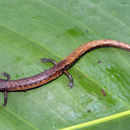Description
provided by AmphibiaWeb articles
This small salamander averages about 35 mm SVL in both adult males and females. It has a short, narrow head with a broadly rounded snout and small nostril openings. In males, the labial protuberances are clearly visible. The eyes, protruding from the side of the head, are hidden by the jaw line when the individual is viewed from below. N. limnospectator possess long tails (tail length/SVL is 1.3 in males and 1.0 in females) that are slightly constricted at the base, giving it an almost rectangular shape. Towards the tip of the tail, the constriction eases, producing more of an ovoid shape. The species has short, thin limbs and small feet with differentiated digits and bluntly rounded toe tips. Both genders have similar coloring; the reddish-brown dorsal region is sprinkled with white spots while the ventral region is a solid chestnut color. These two areas of the body are separated by a cream-colored, lateral stripe. (McCranie and Wilson 2003)Due to its environmental vulnerability, Wilson and McCranie consider Nototriton limnospectator to be an "indicator species" (2002, 2003a, and 2003c). The condition of the N. limnospectator population can reveal the environmental situation in Honduras at a given time.EtymologyNototriton limnospectator obtained its name from the location in which two specimen were discovered. In Greek, "limne" means lake, and a "spectator" is one who observes or beholds. From the point on Montana de Santa Barbara where these two specimen were found, one could clearly see Lago de Yojo.
- McCranie, J. R. , Wilson, L. D., and Polisar, J. (1998). ''Another new montane salamander (Amphibia: Caudata: Plethodontidae) from Parque Nacional Santa Barbara, Honduras.'' Herpetologica, 54(4), 455-461.
- McCranie, J. R., and Wilson, L. D. (2003). ''Nototriton limnospectator.'' Catalogue of American Amphibians and Reptiles. Society for the Study of Amphibians and Reptiles, 763.1-763.2.
Distribution and Habitat
provided by AmphibiaWeb articles
All known specimens of this species have been found on the northwest slope of Montana de Santa Barbara in the eastern area of Deportamento de Santa Barbara, Honduras. Although the type locality was found southwest of San Luis de los Planes (14o56'N,88o08'W) at 1910 m (McCranie et al 1998), Nototriton limnospectator specimens are known to be distributed between the elevations of 1640-1980m in lightly disturbed to primary cloud forests.
Santa Barbara moss salamander: Brief Summary
provided by wikipedia EN
Nototriton limnospectator is a species of salamander in the family Plethodontidae. It is also called the Santa Barbara moss salamander. It is endemic to Honduras.
- license
- cc-by-sa-3.0
- copyright
- Wikipedia authors and editors

